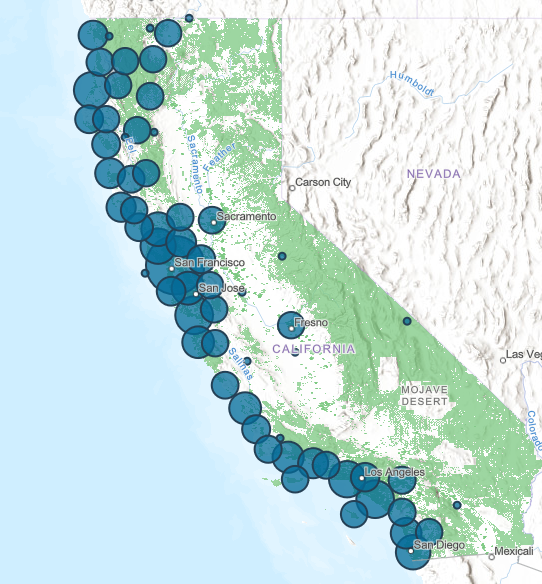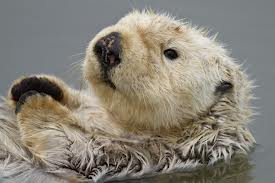Frequently Asked Questions
What is the Coastal Conservancy?
The Coastal Conservancy is a State agency, established in 1976, that protects and improves natural lands and waterways, helps people get to and enjoy the outdoors, and sustains local economies along the length of California’s coast and around San Francisco Bay.
Where does the Coastal Conservancy do its work?
The Conservancy works along the entire length of California’s coast, within the watersheds of rivers and streams that extend inland from the coast, and throughout the nine-county San Francisco Bay Area.
What does the Coastal Conservancy do?
The Conservancy develops and supports projects that protect the natural and scenic beauty of the coast, improve water quality and wildlife habitats, help people get to and enjoy beaches and parklands, keep farmland and timberlands in production, revitalize working waterfronts, and help communities prepare for climate change.
How does the Coastal Conservancy go about its work?
The Conservancy is non-regulatory and achieves its goals by joining forces with local communities, nonprofit organizations, other government agencies, businesses, and private landowners.
What kind of work has the Coastal Conservancy done?
The Conservancy has completed more than 1,500 projects and is actively engaged in hundreds more. Through these projects it has helped protect almost 400,000 acres of natural and working lands, open urban and rural parklands, build hundreds of miles of trails, restore thousands of acres of wetlands and other wildlife habitats, revitalize working waterfronts in dozens of communities, and improve water quality in rivers, streams, lakes, and lagoons.
How does the Coastal Conservancy’s work benefit California’s communities?
Conservancy projects protect and improve natural, scenic, and recreational resources that underpin local economies and improve residents’ quality of life. Many projects have helped communities manage floodwater threats while restoring the health of rivers, creeks, and water bodies. Conservancy-supported parks and trails offer residents convenient opportunities for outdoor recreation, and visitor centers help residents get to know and appreciate nearby natural areas.
How has the Coastal Conservancy’s work targeted underserved communities?
The Conservancy has helped establish community parks within low-income areas and multi-use trails that link those areas to regional destinations. Conservancy projects have restored creeks and natural lands adjacent to underserved communities and coordinated use of those lands with science education programs of nearby schools. The Conservancy also supports programs to bring low-income students and families on field trips to explore, learn about, and simply enjoy California’s spectacular coast.
How does the Coastal Conservancy select its projects?
Conservancy projects are selected both formally, through programs with structured grant-application procedures, and informally, through inquiries made to Conservancy staff. Projects recommended by staff for funding are considered at open public meetings of the Conservancy’s governing board. All Conservancy projects must meet the agency’s project criteria and advance its strategic plan, whose goals and objectives are consistent with State and regional planning efforts and established statewide priorities.
Where does the Coastal Conservancy get funding for its projects?
The primary source of Conservancy funding has been general obligation bonds approved by California’s voters. The Conservancy has put more than $1.3 billion to work and has leveraged far more from federal, local government, and private sources. The Conservancy has been particularly successful in receiving federal funding for its projects.
How does the Coastal Conservancy measure its success?
Since 1997 the Conservancy has adopted multi-year strategic plans that contain specific objectives for each of several program areas. Conservancy staff continuously monitors the progress of meeting those objectives and assesses that progress in annual reports that are released for public review. Individual projects are also monitored by Conservancy staff on a regular basis to determine if they are achieving their purposes.
How is the Coastal Conservancy governed?
The Conservancy has a seven-member governing board consisting of four public members—two appointees of the Governor of California, one of the Senate Rules Committee, and one of the Speaker of the Assembly—and three officers of other State agencies: the Secretary for Natural Resources, the Director of the Department of Finance, and the Chair of the California Coastal Commission. Six members of the Legislature, three from each house, provide oversight and participate in Conservancy activities.
Where does the Coastal Conservancy fit in the State’s government?
The Coastal Conservancy is one of ten State conservancies within the California Natural Resources Agency.
How does the Coastal Conservancy differ from other State conservancies?
The Coastal Conservancy has a broader spectrum of objectives and a larger jurisdictional area than the other State conservancies. Its area of work is far more diverse, covering urban and rural parts of 28 counties that are home to more than 28 million people—almost three-quarters of the State’s population.
How is the Coastal Conservancy authorized to do its work?
The Conservancy’s responsibilities are specified in Division 21 of the California Public Resources Code. Other State and federal statutes also authorize the Conservancy’s work.
Does the Coastal Conservancy have additional responsibilities?
The Conservancy is one of three California administrators—along with the Coastal Commission and the San Francisco Bay Conservation and Development Commission—of the National Coastal Zone Management Program authorized by the federal Coastal Zone Management Act of 1972. The goal of that act is to preserve, protect, develop, and, where possible, to restore or enhance the resources of the nation’s coastal zone.
How is the Coastal Conservancy addressing climate change?
The Coastal Conservancy is working with communities throughout California’s coast to help them adapt to climate change and mitigate its causes. This work includes assessments of threats from climate change—such as rising seas, extreme weather events, beach and bluff erosion, flooding, and drought—and actions to counter those threats. The Conservancy is also supporting work to reduce emissions of greenhouse gasses into the atmosphere and to capture and sequester those gasses.
How will the Coastal Conservancy put funds from the 2014 water bond to use?
The Conservancy will lend its more than 35 years of experience to increasing the reliability of water supplies, improving water quality, and protecting the watersheds of coastal rivers and streams. It has long worked on projects that are consistent with the objectives of the water bond, including:
- Restoration of wetlands that filter pollutants, recharge groundwater basins, and provide habitats for fish and wildlife
- Restoration of the watersheds of rivers and streams to improve water quality, protect the integrity of adjacent lands, and improve management of floodwaters
- Removal of trash and other pollutants from urban rivers and streams to improve water quality and protect ocean waters and beaches
- Harvesting of rainwater in urban parks and residential areas to recharge groundwater and reduce stormwater runoff
- Restoration of rural ponds that support livestock and wildlife and recharge groundwater
- Removal of barriers to migrating salmon and trout.
How can my organization get a grant from the Coastal Conservancy?
Information about obtaining a grant from the Conservancy can be found at https://scc.ca.gov/grants/.
Latest News
- Press Release: Coastal Conservancy Awards over $40 million for coastal access, restoration, and climate resilienceOakland, CA (4/18/2024) – Today, the Board of the State Coastal Conservancy approved grants totaling over $40 million for coastal access, restoration, and climate resilience. Among the grants awarded today are: A grant of up to $6,000,000 to Humboldt County Resource Conservation District to undertake the North Coast Wildfire Resilience Planning and Implementation Grant Program, which […] (Read more on Press Release: Coastal...)
- Sea Otter Recovery Grants RFP Now Open!The California State Coastal Conservancy announces the availability of grants to public agencies, tribes and nonprofit organizations for projects that facilitate the recovery of the southern sea otter along California’s coasts. The California Sea Otter Fund is one of the state’s tax check-off funds that allows taxpayers to voluntarily contribute to the recovery of California’s […] (Read more on Sea Otter Recovery...)
- Coastal Conservancy Public Meeting in Oakland – April 18Meeting Notice Douglas Bosco (Public Member), Chair Marce Gutiérrez-Graudiņš (Public Member), Vice Chair Joy Sterling (Public Member) Jeremiah Hallisey (Public Member) Wade Crowfoot, Secretary for Natural Resources; Bryan Cash and Jenn Eckerle (Designated) Caryl Hart, Coastal Commission Chair; Madeline Cavalieri (Designated) Joe Stephenshaw, Director, Department of Finance; Michele Perrault (Designated) Senate Representatives Benjamin Allen (District […] (Read more on Coastal Conservancy Public...)

 Help Save Sea Otters at Tax Time
Help Save Sea Otters at Tax Time

